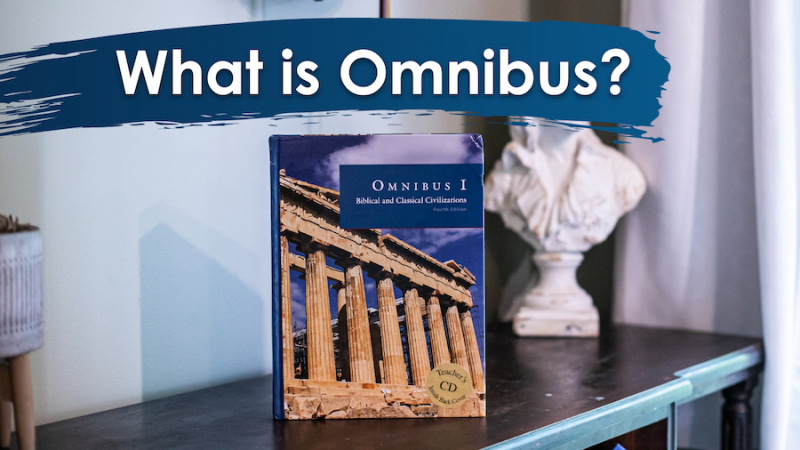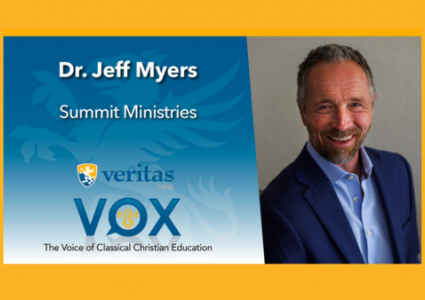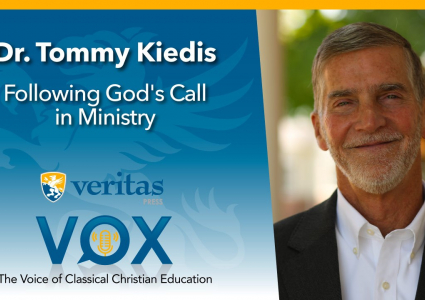What exactly is Omnibus?

Omnibus: the #tldr (too long, didn’t read) version
Omnibus is Veritas' signature Great Books curriculum that teaches students lessons from the past in order to live in the present. Omnibus is a Latin term meaning "all-encompassing."
- A year of Omnibus includes one year-long Primary class and one year-long Secondary class.
- Primary courses emphasize primary sources, such as books from the time period.
- Secondary courses emphasize books related to the theme and shed further light on the subject.
- Each year of the Omnibus curriculum combines history, theology, and literature to help students see how these three spheres have influenced each other throughout all of time.
- Completing the Primary and Secondary of one Omnibus course together translates into 3 credits for every Omnibus year your student completes. If you want your student to start Omnibus in 7th grade, you would start with the Omnibus 1 Secondary and Primary Courses if you think your student is mature enough for Omnibus readings and topics covered (please review the book list for each Omnibus level for maturity-content levels).
- However, non-Diploma students can start Omnibus 1 whenever they like- even in 12th grade if they want to study Omnibus for just one year and happen to need ancient history.
- Omnibus I, II, and III are high school honors level (so it shouldn't be taken lightly to have your 7th grader start Omnibus). Omnibus I, II, and III are one history cycle- ancient, medieval, and modern.
- Omnibus IV, V, and VI are dual-enrollment (college level) and repeat the history cycle. Depending on the desired history and level of literature goals, you can start/end anywhere in the Omnibus course.
And that is Omnibus in a nutshell! Want to dig deeper? Read On. But first, check out this clip from one of our live-online Omnibus teachers, Sarah Gavin:
Where and When to Begin
When done in its entirety, Omnibus includes six years with two simultaneous courses (Primary and Secondary) each year. The Omnibus Primary course focuses closely on primary-source historical works and events from the time period covered. The Omnibus Secondary course covers secondary-source books. Secondary offers balance and a slightly lighter workload. It also focuses more on literature and theology of the same period than the Primary course covers.
You do not have to correlate Omnibus levels to grade levels. This may be confusing to understand just how customizable Omnibus is for 7th - 12th grade. We highly encourage you to reach out to a Family Consultant to see which level of Omnibus you should start with for your student.
For the chart below, grade Level is only reflected based on wanting to complete all 6 years. Grade level doesn't explicitly correlate to Omnibus level.
*“Omnibus” in this chart references both Primary & Secondary Omnibus courses done together.
Do you have to do ALL 6 years of Omnibus?
Many ask, "Can we do only a year or a few years, or only primary, or only secondary courses?" Our answer is the same: Yes! Any study of the Great Books will be of value in your student’s growth as they learn to face the issues of this world with a biblical perspective. You can do one year or all six; the choice is yours, depending on the academic goals of your students.
Whether you plan to do all twelve classes over six years or only one, students will benefit for the rest of their lives by joining the "Great Conversation." How many classes you take may depend on how you plan to use Veritas to fulfill your student’s high school credit. In this article, we will detail what courses to take. But first, you can decide how you’ll take the classes. Learning can happen in all three formats: You Teach, Self-Paced, and Live Online.
Self-Paced Vs. Live-Online Vs. You-Teach
Which version of the Omnibus curriculum is right for your family? It depends upon your student’s goals, abilities, and learning styles and how much or little time you, as a parent, have to put into the program. We hope the chart below helps highlight which program has what you are looking for:
*”Up to you” means you provide the means and decide how and if it gets done!
** How to choose what books you read in Self-Paced: courses may be set up as an “Audit”, which would allow you to skip over sections and readings you do not wish to complete. Auditing forfeits having your course graded or eligible for the Diploma Program. Email info@veritaspress.com to request your Self-Paced course to be converted to Audit format.
***Self-Paced Omnibus is available in Primary & Secondary, levels 1-3 only.
Want a sneak peek of what you can expect in a Self-Paced Omnibus course? Watch the video below.
How to Incorporate Omnibus in Your High School Transcript
Omnibus is not a term understood by colleges on transcripts. Consequently, we have developed course language that colleges understand and accept. The chart below provides the names we recommend if a student has taken both the Primary and Secondary courses in a 12-month period:
Calculating a Combined Grade:
Students are required to take both Primary and Secondary courses of the same Omnibus level within the same 12-month period in order to receive the full three credits. Primary courses are weighted 60% and Secondary courses 40% for a final combined grade using the formula below. This grade is applied to each course credit.
(Primary course grade x 0.6) + (Secondary course grade x 0.4)
Students who complete either a Primary or a Secondary Omnibus course, but not both within 12 months, should be given one credit. The following chart provides the recommended course names for transcripts:
How to Choose Which Omnibus Course to Take
No matter how you look at it, at its core, Omnibus requires copious amounts of reading. Parents using the Omnibus Self-Paced and You-Teach kits often ask, “Could we do Omnibus II before Omnibus I because we find its readings easier?” and other questions about variations to the official sequence. This is not a question of absolute right or wrong. It is a question of prudence—what is wise to do next for your unique student and situation?
First, there are three pre-considerations needed to answer this question:
1. How much time do you have to spend on Omnibus? If you’re teaching Omnibus for the first time and you have, for example, an 11th grader, think about what two Omnibus years you want to cover. Don’t try to cover six years of curriculum in two years- that is impossible. You might cause your child to hate the Great Books, reading, and school. Pick what works best for your student, and what history they still need to complete.
2. Is your child a strong reader? If they are a strong reader, focus on the more challenging books. If your child is not a big reader, initially focus on easier books or earlier years. You can always build up from there. Start where you are, not where you want to be. Also, if they can listen to audible books and retain what they hear, your student will be able to keep up.
3. Do you want a flyover view or a deep understanding? Consider whether you and your student(s) value depth or breadth more. We would recommend depth (self-paced and live courses), but if your child really needs more of a survey (which can only be done through You Teach), then width or speed might provide greater value. Think through what you value when planning your year of reading, and know that you might have to alter your plan as you go along - that is ok!
With those three things in mind, here are three considerations for figuring out which Omnibus to take and when:
Consideration 1: Are you changing the sequence because you think a different year is easier?
Ask yourself: why are you changing the sequence? Be careful that you’re not changing it because you want to avoid the hard stuff. If you consistently apply this principle, your child will never build the reading muscles that they need. That said, you must take their abilities into account. Always keep pushing, but don’t push more than your child can bear!
Consideration 2: Are you changing the sequence because you think a different year is more accessible or important?
The Omnibus curriculum is made to get more challenging as time goes along. You can see this particularly when you look at the Omnibus Secondary book lists. Omnibus Secondary can start as early as 7th grade with a lot of Narnia and covers tougher titles over time (however, you can start Omnibus I as late as 10th grade and still get through a fully history cycle of Omnibus I,II,II before your student graduates high school).
If you’re going to alter the order you do the courses in, we suggest you plan out multiple years—not just next year. If you don’t plan the order ahead of time, you’re likely to hit a point where the courses no longer flow well in either subject matter or difficulty.
Consideration 3: Are you changing the sequence because your student is struggling with the work?
This is the toughest consideration and takes the most prudence. The best place to start is by altering the list for the year your student is on and picking the easiest books to focus on. Use these easier books like a gymnasium. Help the students build muscles until they are ready to lift more weight.
The curriculum will serve your family the best if you strive to find the easier books within the year you have decided to do instead of switching years. Instead of changing the sequence of years, consider gearing down the speed and difficulty of the reading for your current Omnibus year until the student is ready for harder work.
How do I teach Omnibus myself?
When doing You-Teach Omnibus
1. Be sure you purchase the Omnibus textbook that comes with the teacher CD. The teacher CD will be a valuable resource to you as you grade your student’s work and discuss the books with them.
2. Read as many of your students’ assigned books as possible. This will enable you to have quality conversations with them about the materials and topics covered. Those conversations have the potential to be one of the best and most memorable parts of Omnibus for you and your student! If you don’t have time to sit down with physical books, many parents choose to listen to audiobook versions as they accomplish the day’s tasks.
If you would like to dive in and learn all there is to know about teaching Omnibus, we have something truly special to share with you: the training seminar that we offer to all of our professional Omnibus teachers who teach our live-online courses.
How to Teach Omnibus: Session 1
This lecture covers three session types: the prelude, recitation, and writing assignments.
How to Teach Omnibus: Session 2
This lecture covers discussion classes. They are the most prevalent session type.
How to Teach Omnibus: Session 3
This lecture covers two session types: activities and evaluations.
Omnibus FAQ
Q. Wow! That’s a lot of books. How can my student get through them all?
A. When first learning about Omnibus some are concerned with difficulty and enjoyability. The readings for the Omnibus can seem overwhelming. Students should be encouraged to learn to skim some sections—Herodotus’s Histories is an example—and to enjoy the richness of others—Homer’s Odyssey, for example. But at the end of the day, they can listen to some of them on Audible while riding their bike or mowing the lawn. The reading can be fully accomplished, however, that looks like in your family.
Q. How long does the Omnibus reading take each day?
A. That can vary from student to student depending on their comprehension, reading ability, and technique. For some students, that is an hour or two per day; for others, it can be much more.
Q. What if we can’t do all 6 years of Omnibus?
A. Pick what history your student needs to complete for their high school transcript. Then choose if you want high school honors (Omnibus I, II, III) or a dual enrollment option (Omnibus IV, V, VI). That will guide you in what Omnibus course to take.
Q. Omnibus Primary and Secondary are separate classes, but I don’t see “Primary” or “Secondary” listed on the textbooks in the Veritas Press store. How do I know what book to buy?
A. Each level Omnibus textbook covers both Omnibus Primary and Omnibus Secondary, all in one book! Watch the video below to learn more about Omnibus textbooks:
Q. My student is geared toward STEM. What use is a Great Books education in that field?
A. You can read all about the benefits that Omnibus can offer students in the STEM world HERE.
Q. Will Omnibus help my students when they go to college?
A. Not only are all Omnibus courses completed through our Live-Online classes considered honors-level on high school transcripts, but there are also many other reasons why an Omnibus education will give your student an advantage in college. You can read about those benefits HERE.
Q. Some of the Omnibus books describe characters doing things that are condemned in the Bible. Why is content like this included?
A. The Great Books include examples of both virtue and vice that are intended to spark discussions that will cement a true appreciation of Biblical morality in students. You can read a full explanation of how the Omnibus curriculum is designed to help your students become capable followers of Christ and conscientious spiritual leaders HERE.
Q. What makes the books on the Omnibus list “Great Books”?
A. There are several criteria that we took into consideration when building the reading lists for Omnibus. You can learn about them HERE.
Ready to dig into a course? Here are links to all of our courses.
SP Omnibus About Page
Building an Omnibus Transcript
Omni 1 Primary Learning Options
Omni 1 Secondary Learning Options
Omni 2 Primary Learning Options
Omni 2 Secondary Learning Options
Omni 3 Primary Learning Options
Omni 3 Secondary Learning Options
Omni 4 Primary Learning Options
Omni 4 Secondary Learning Options
Omni 5 Primary Learning Options
Omni 5 Secondary Learning Options
Omni 6 Primary Learning Options
Omni 6 Secondary Learning Options
Are you still wanting MORE info?! If you’re still here, you are one committed parent; way to do all the research to know Omnibus on an even deeper level!
The list below are blog posts on specific Omnibus topics. Have fun perusing our “bookshelf”!
In the Classroom: Josiah Peterson's Student Guide to Omnibus
Tour of Omnibus Series, Part 2: History, Herodotus, Thucydides, & Tuchman
The Power of Language: The Blessing of Omnibus in Reading, Testing, and Writing
Three Ways Omnibus Discussions Can Teach us to Think and Lead
College, Career or College: How Classical Education Prepared Me
Three Ways a Great Books Education Prepares Students to be Spiritual Leaders
3 Ways the Great Books CAN Prepare Children for Communion with God
How Reading the Great Books Prepares Students for Standardized Tests in Incredible Ways
3 Ways the Great Books Rescue Us from the 24-Hour News Cycle
5 Ways Omnibus Helps Students Be Discerning About Modern Politics






